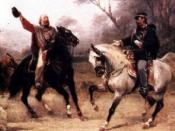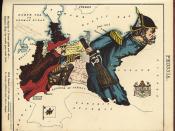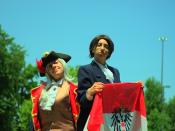Italian and German Unification After 1848, Italian nationalists looked to the kingdom of Sardinia for leadership because Mazzini had failed in Rome. Sardinia's king, Victor Emmanuel II named Count Camillo di Cavour his prime minister. Cavour was a wealthy aristocrat and a moderate nationalist. He also was a realpolitik. Realpolitiks were shrewd,purposeful politicians who wanted to unite Italy by well chosen alliances, not romantic rebellions like Mazzini. He made uniting Italy his highest priority. Cavour believed that careful diplomacy and well-chosen alliances were better than romantic rebellions. Austria was his biggest obstacle.
He would need help from another power to get rid Austria out of Italy. Cavour allied with Napoleon III of France, who wished to make France Europe's greatest power. He gave France Nice and Savoy. They took it to dominate Italy.
While Cavour was uniting Northern Italy, he was also secretly helping Southern Italy. In 1860, an army of about 1100 sailed from Genoa to Sicily.
Giuseppe Garibaldi led them. They were known as the Red Shirts because Garibaldi would always wear a red shirt during battle. He was a bold and romantic soldier. He was victorious in Sicily and began marching north to his hometown of Nice. Because Cavour had given it up to France and did not want to disturb France at all, so he arranged for King Victor to meet with Garibaldi in Naples. At the meeting, the "Red One"ÃÂ agreed to step aside and let King Victor rule the lands he conquered. In 1861, the Italian Parliament met at Turin and declared Victor Emmanuel II king of all off Italy. This new nation thus had a government headed by a constitutional monarch and an elected parliament.
Like Italy, Germany finally achieved unity in the mid- 1800's. Since 1815, 39 German states had formed a...


